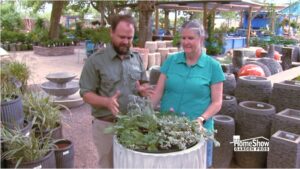Houston Organic Garden Tips & Advice
Transcript:
Sherri Harrah:
Wow, look at this amazing specimen of a tree. Hi, I’m Sherri with Home Show Garden Pros and I’m joined today with Ed Dolphin, who’s an ISA certified arborist. And we are here at this beautiful tree to talk to you guys about the dos and don’ts of pruning because there’s a lot of mistakes people make. Ed so for instance, right here, what are you thinking about this pruning job?
Ed Dolphin:
Sherri, I don’t have a problem with this particular cut because it was cut at the branch collar and the branch collar is… on every branch, there is a collar and if you know, can distinguish where that collar is, you can make a good cut. Even the untrained homeowner can make a good cut. This was a good cut. You can see the callus wood here has begun to grow. This callus wood is probably 25 to 30 years old and it will take another 40 years before they meet in the middle and form a scar.
Sherri Harrah:
Okay. And that’s probably true when this neighborhood was developed.
Ed Dolphin:
And so they probably cut this limb off because it was too low and hanging in the street.
Sherri Harrah:
On the street. Yeah. Okay. So that brings me to my next thought. People ask all the time to use pruning paints or not. What’s your opinion?
Ed Dolphin:
In Austin in the spring, use pruning paints.
Sherri Harrah:
Okay.
Ed Dolphin:
Fortunately, we don’t have the disease here that pruning paint helps to prevent, oak wilt. Knock on wood, we don’t have oak wilt. It got as far as Brenham and stopped. Why? I don’t know. But it didn’t.
Sherri Harrah:
Let’s hope it stays that way.
Ed Dolphin:
Yeah, it stays that way. But pruning sealant helps to deter the nitidulid beetle that carries that pathogen.
Sherri Harrah:
That’s attracted to that cut and then-
Ed Dolphin:
Yes.
Sherri Harrah:
Okay. Gotcha. So use it or not, but it’s not necessary.
Ed Dolphin:
Right now when somebody asks me, do you use pruning sealant when you prune my trees? No, it’s not necessary.
Sherri Harrah:
Okay, great.
Ed Dolphin:
It makes the homeowner feel better than the tree.
Sherri Harrah:
Right.
Ed Dolphin:
But let me show you some things that I do see on this tree.
Sherri Harrah:
Okay, great.
Ed Dolphin:
Like this limb right here where it’s obviously broken already.
Sherri Harrah:
Mm-hmm.
Ed Dolphin:
And you can see under there that browns thing that looks like a fungal mat.
Sherri Harrah:
It’s almost like a mushroom. Yeah.
Ed Dolphin:
Yeah. It’s a fungal mat called Hypoxylon canker.
Sherri Harrah:
Right.
Ed Dolphin:
And Hypoxylon canker affects dying wood.
Sherri Harrah:
Right. So it’s not going to go get on a living tree, but just on the dying wood.
Ed Dolphin:
The on the dying wood from the living tree. Now can it transfer all the way into the stem? It can. It’s a vascular disease. Hypoxylon canker is to a tree like if you went to your doctor and your doctor said that your cholesterol level was at 800, you’ve got some serious vascular problems.
Sherri Harrah:
Right.
Ed Dolphin:
This limb died because it was stripped out.
Sherri Harrah:
By bad pruning.
Ed Dolphin:
By bad pruning. And this whole tree was, I can tell by looking at the interior growth that the whole tree was stripped out probably about five years ago. And it’s put on new growth because it needs it. A lot of people will say, “Oh, the tree doesn’t need it.” Trees don’t do anything that they don’t have to do. So this limb, the best thing that could happen to this poor tree would be this limb is cut off. So that disease does not go into the main stem because once it’s in the main stem, it’s there.
Sherri Harrah:
Now most people don’t have a tree this size of course. So you’d have to call somebody to come and cut this size tree. But in a homeowner’s environment, if they notice that Hypoxylon canker on some dying wood and they wanted to cut it, they could just get up there and prune it off.
Ed Dolphin:
And make a good cut.
Sherri Harrah:
Do they need to disinfect their pruners?
Ed Dolphin:
It wouldn’t be a bad idea, but it’s not necessary as long as you’re making a good cut. Because really and truly, the disease that’s here is not at the branch collar.
Sherri Harrah:
Okay.
Ed Dolphin:
Cut it there. And you’re good.
Sherri Harrah:
Great to know. Yeah.
Ed Dolphin:
Now here’s another consequence of stripping out trees. This one, this limb was stripped out completely and now subsequently it’s dead. And you can see where there’s no green on it at all and it’s dead. The best thing that could happen for this tree would be for it to be cut off right up there so that it does not develop any disease.
Sherri Harrah:
The canker moves over here.
Ed Dolphin:
Right. Yeah.
Sherri Harrah:
Gotcha.
Ed Dolphin:
So let’s look at another place that we could literally show a good example of making a good cut and-
Sherri Harrah:
And where some cuts have been made so you can kind of see.
Ed Dolphin:
So right here you can see where they made a straight cut. It’s not the best, but you can see the callus wood and the callus wood over here. We’ll get rid of the ball moss.
Sherri Harrah:
Ball moss.
Ed Dolphin:
And the tree is eventually going to close this over. This over here was actually a better cut. And the tree is eventually going to close this over. But even a small cut can take 10 to 15 years before it completely closes over. Now this right here was a terrible cut because they left a six-inch stub. And this right here is going to literally have to rot, decay, and fall off before the tree will close that over-
Sherri Harrah:
Callus.
Ed Dolphin:
With the callus wood.
Sherri Harrah:
Which could take several years right?
Ed Dolphin:
Which could take decades.
Sherri Harrah:
Yeah. And this one right here has decayed where they cut. So they left a little nub. So it’s finally decayed.
Ed Dolphin:
Yeah. And now-
Sherri Harrah:
And now it’s going to be able to callus over.
Ed Dolphin:
Now the tree will be able to callus over.
Sherri Harrah:
Right.
Ed Dolphin:
Yeah.
Sherri Harrah:
Awesome. Well for more information and great tips like this from Ed, join us on Saturday mornings from 7:00 to 9:00 on Home Show Garden Pros.












